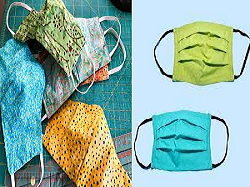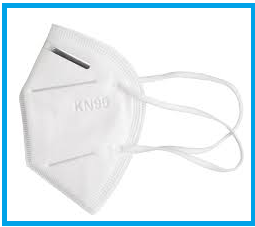Types of Masks and Respirators: A novel coronavirus SARS-CoV-2 emerged in China in late 2019 and since then, it has rapidly spread throughout the world. Some of the other day we read in the news that new COVID-19 variants are emerging. Amid Omicron fear, recently, a new variant of COVID-19 sub-lineage B.1.640.2 or IHU has been detected in France.
Therefore, it is necessary to take precautionary measures including wearing masks, social distancing, etc. Here, we are listing various types of masks and respirators that can be used to protect you from getting and spreading COVID-19.
Masks are designed in such a way as to contain an individual's respiratory droplets and particles. Also, they provide protection from particles expelled by others.
What are respirators?
According to the CDC, respirators protect from particles like the virus that causes COVID-19, and in doing so they also contain a person's respiratory droplets and particles so that a person does not expose others. Respirators also protect users by removing contaminants from the air including particulate respirators, and gas masks. They also protect by supplying clean respirable air from another source like airline respirators, etc.
Different types of Masks and Respirators
According to the CDC, different types of masks, their effectiveness, and respirators for preventing COVID-19 are as follows:
1. Cloth Masks

Cloth masks can be made from different fabrics and in the market several types of cloth masks are available.
Conditions for wearing cloth masks
- It is recommended that while wearing a cloth mask it should fit over the nose and mouth to prevent leaks.
- Tightly woven, multiple layers, and breathable fabric.
- Nose wire
- Cloth fabric should be like it blocks light when held up to a bright light source.
As per CDC, don't wear cloth masks that have gaps around the sides of the face or nose, vents, or other openings, and of single layer fabric or made of thin fabric that does not block light.
According to Trish Greenhalgh, professor of primary health care services at the University of Oxford "Cloth mask can be really good or really bad, depending on what fabric is used."
2. Disposable Masks

These types of masks are widely available and are sometimes referred to as surgical masks or medical purpose masks.
Conditions for wearing disposable masks
- Disposable masks should fit over the nose and mouth to prevent leaks.
- It should have multiple layers of non-woven material
- Nose wire
As per the CDC, it is recommended not to wear disposable masks that have gaps around the sides of the face or nose and wet or dirty material.
3. Extra Protection Masks
- Wear two masks for extra protection. As per the CDC, wear a disposable mask underneath and a cloth mask on top.
- Combine both masks with a fitter or brace.
- Wear masks that attach behind the neck and head with either elastic bands or ties instead of ear loops.
As per, Trish Greenhalgh, "Double or triple-layer masks made of a mix of materials can be more effective, but most cloth coverings are just "fashion accessories."
4. Masks that meet a Standard
There are some masks that are designed and tested to ensure that they perform at a consistent level. These types of masks are labeled and tell you what standards they meet. Such masks are labeled as MEETS ASTM F3502, MEETS WORKPLACE PERFORMANCE, and MEETS WORKPLACE PERFORMANCE PLUS.
As per the CDC, don't wear these masks if a person has certain types of facial hair, if hard to breathe or difficulty breathing, if wet or dirty, with other masks, and as a replacement for NIOSH-approved respiratory protection when required on a job.
Now, the question arises of how to wear these types of masks. It is said that while wearing follow the instructions of the manufacturer, store, and clean or dispose of the mask properly.
5. Respirators that meet International Standards (KN95s)

Some respirators are designed and tested to meet international standards and are labelled to tell what standards they meet. As per the CDC, the most widely available respirators that meet an international standard are KN95s. Other examples are 1st, DL2, DL3, DS2, DS3, FFP2, FFP3, KN100, KP95, KP100, P2, P3, PFF2, PFF3, R95, and Special.
6. NIOSH-Approved Respirators (N95)
NIOSH approves various types of filtering facepiece respirators and the most widely available are N95. Other examples are N99, N100, P95, P99, P100, R95, R99, and R100.
As per the CDC, specially labeled "surgical" N95 respirators should be prioritized for healthcare personnel. Also, it is recommended that employers who distribute N95 respirators to employees shall follow an Occupational Safety and Health (OSHA) respiratory protection programme.
About N95 respirators
- It filters up to 95% of particles in the air when approved by NIOSH. Also, proper fit can be achieved.
- It should seal tightly to the face, fitted properly.
- Also, N95 respirators seal the face so it may be difficult to breathe through than a cloth mask.
- These types of respirators cannot be washed. When they are dirty or damaged, difficult to breathe through then they need to be discarded.
- N95 respirators tend to be more expensive than masks.
7. Alternative Masks for special situations
An alternative type of masks may include clear masks or cloth masks with a clear plastic panel that may be helpful when interacting with certain groups of people including people who are deaf or hard of hearing, young children or students learning to read, students learning a new language, people with disabilities, and people who need to see the proper shape of the mouth for making appropriate vowel sounds like when singing.
A transparent medical mask is recommended by the FDA. These types of masks should be reserved for use by healthcare workers and patients who require them. While using these types of masks, make sure that a person is able to breathe easily and excess moisture does not collect inside the mask.
There are situations that may have a higher risk of exposure to COVID-19 than others. So, it is necessary to consider the type of mask or respirator depending upon the situation. It is recommended to choose a well-fitting and comfortable mask or respirator and wear it properly that covers the nose and mouth.
Also, it is necessary to follow other precautionary measures with wearing masks like cleaning hands frequently, maintaining social distancing, being conscious of the face that is only touching face or mouth with clean hands, etc.
Comments
All Comments (0)
Join the conversation